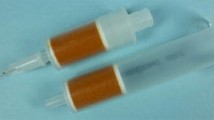Summary
In TLC screenings of 335 urine samples taken because of suspicion of heroin consumption, positive evidence of morphine was found in about 50% of the cases, which was confirmed without exception by gas chromatography-mass spectrometry.
In 66% of the positive cases, morphine and codeine were found; in about 31% only morphine was found, and the median value of 0.4 mg/l free morphine and 1.0 mg/l conjugated morphine was considerably lower than in the whole collection of samples.
Comparison of the codeine/morphine quotients (Q), especially the free bases, proves that the groups of heroine/morphine or codeine consumers can be distinctly differentiated.
The critical conditions of the conjugated bases worked out by Dutt et al. (1983) proved to be right.
Using the equation Qf<0.5 \(\sqrt 5 \), a boundary condition for the free flare bases can also be developed, which is dependent on the sum of the codeine and morphine concentrations and which proves heroin/morphine consumption with 98% certainty.
Zusammenfassung
Ein dünnschichtchromatographisches Screening von 335 Harnproben, die bei Verdacht auf Heroinkonsum asserviert worden waren, ergab in ca. 50% der Fälle einen positiven Morphiat-Nachweis, der sich in allen Fällen gaschromatographisch-massenspektrometrisch bestätigen ließ. Bei ca. 66% der positiven Fälle fanden sich sowohl Morphin als auch Codein, bei ca. 31% nur Morphin, wobei die Medianwerte hier mit 0,4 mg/l für freies Morphin und 1,0 mg/l für gebundenes Morphin erheblich niedriger lagen als im Gesamtkollektiv.
Die Gegenüberstellung der Codein/Morphin-Quotienten (Q) läßt vor allem bei den freien Basen eine deutliche Trennung der Kollektive von Heroin/Morphin- bzw. Codein-Konsumenten erkennen. Bei den konjugierten Basen erweisen sich die von Dutt et al. (1983) entwickelten Grenzbedingungen als zutreffend. Bei den freien Basen wird darüber hinaus in Abhängigkeit von der Summe der Codein- und Morphin-Konzentrationen (c) anhand der Gleichung Qf<0,5 \(\sqrt 5 \) eine Grenzbedingung entwickelt, die mit 98%iger Sicherheit einen Heroin/Morphin-Konsum beweist.
Similar content being viewed by others
Literatur
Adler TK, Fujimoto JM, Way EL, Baker EM (1955) The metabolic fate of codeine in man. J Pharmacol Exp Ther 114:251–261
Albanbauer J, Fehn J, Furtner W, Megges G (1978) Quantitative Hochdruck-Flüssigkeits-chromatographie von Rauschgiften. Arch Kriminol 162:103–107
Börner U, Abbott S (1973) New observations in the metabolism of morphine. The formation of codeine from morphine in man. Experientia 29:180–181
Budd RD, Mathis DF, Leung WJ (1980) Screening and confirmation of opiates by thin-layer chromatography. Clin Toxicol 16:61–66
Dutt MC, Lo DST, Ng DLK, Woo SO (1983) Gaschromatographic study of the urinary codeine-to-morphine ratios in controlled codeine consumption and in mass screening for opiate drugs. J Chromatogr 267:117–124
Ebbighausen WOR, Mowat J, Vestergaard P (1973) Mass fragmentographic detection of normorphine in urine of man after codeine intake. J Pharm Sci 62:146–148
Elliott HW, Nomof N, Parker KD (1967) Correlation of the nalorphine test with concentration of metabolites of codeine in the urine after single doses and continuous administration of codeine. Clin Pharmacol Ther 8:78–85
Elliott HW, Parker KD, Wright JA, Nomof N (1971) Actions and metabolism of heroin administered by continuous intravenous infusion to man. Clin Pharmacol Ther 12:806–814
Fehn J, Megges G (1985) Der forensisch-toxikologische Nachweis des Heroinkonsums. Vortrag auf Symposium „Forensische Probleme des Drogenmißbrauchs“, Mosbach, 26.-27.4.85; Detection of O6-monoacetylmorphine in urine samples by GC/MS as evidence for heroin use. J Anal Toxicol 9:134–138
Geldmacher-von Mallinckrodt M (1976) Einfache Untersuchungen auf Gifte im klinisch-chemischen Laboratorium. In: Breuer H, Büttner H, Hillmann G, Stamm D (Hrsg) Klinische Chemie in Einzeldarstellungen, Bd 2. Thieme, Stuttgart
Goenechea S, Goebel K-J (1978) Verhalten von Morphin-3-Glucuronid bei der Hydrolyse mit Salzsäure. Beitr Gerichtl Med 36:503–507
Goenechea S, Kobbe K, Goebel K-J (1978) Verhalten von Codein und Codein-6-glucuronid bei der Hydrolyse mit Salzsäure. Arzneimittelforsch (Drug Res) 28:1070–1071
Goenechea S, Brzezinka H (1982) Morphinnachweis im Harn nach Einnahme von Codein. Fresenius Z Anal Chem 313:331–333
Käferstein H, Staak M (1982) Rechtsmedizinische und forensisch-toxikologische Probleme des Betäubungsmittel-Konsums. Dtsch Ärztebl 79:53–59
Mannering GJ, Dixon AC, Baker EM, Asami T (1954) The in vivo liberation of morphine from codeine in man. J Pharmacol Exp Ther 111:142–146
Moosmayer A, Besserer K (1981) Renale Codein- und Morphin-Ausscheidung nach Codein-Einnahme. Beitr Gerichtl Med 39:109–112
Müller EM, Neumann H, Fritschi G, Halder T, Schneider E (1983) Vergleichende gaschromatographische Untersuchungen von Heroinproben. Arch Kriminol 173:29–35
Nelson PE, Fletcher SM, Moffat AC (1980) A combined high-performance liquid chromatography and immunoassay method for the analysis of morphine, codeine and their metabolites in biological fluids. J Forens Sci Soc 20:195–202
Nomof N, Elliott HW, Parker KD (1977) Actions and metabolism of codeine (methylmorphine) administration by continuous intravenous infusion to humans. Clin Toxicol 11:517–529
Paerregaard P (1958) The liberation of morphine from codeine in man and dog. Acta Pharmacol Toxicol 14:394–399
Posey BL, Kimble SN (1983) Simultaneous determination of codeine and morphine in urine and blood by HPLC. J Anal Toxicol 7:241–245
Redmond N, Parker JM (1963) Metabolism of codeine: Urinary excretion rate of codeine and morphine. Canad J Biochem 41:243–245
Solomon MD (1974) A study of codeine metabolism. Clin Toxicol 7:255–257
Yeh SY (1975) Urinary excretion of morphine and its metabolites in morphine-dependent subjects. J Pharmacol Exp Ther 192:201–210
Yeh SY, Gorodetzky CW, McQuinn RL (1976) Urinary excretion of heroin and its metabolites in man. J Pharmacol Exp Ther 196:249–256
Yeh SY, Gorodetzky CW, Krebs HA (1977) Isolation and identification of morphine 3- and 6-glucuronides, Morphine 3,6-diglucuronide, morphine 3-ethereal sulfate, normorphine and normorphine 6-glucuronide as morphine metabolites in humans. J Pharm Sci 66:1288–1293
Author information
Authors and Affiliations
Rights and permissions
About this article
Cite this article
Sticht, G., Käferstein, H. & Staak, M. Methodik und Interpretation des Morphiat-Nachweises in Harnproben. Z Rechtsmed 95, 85–96 (1985). https://doi.org/10.1007/BF00201188
Received:
Issue Date:
DOI: https://doi.org/10.1007/BF00201188




